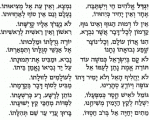Who wrote Yigdal? – Ask the Rabbi
 Q. Who was the author of Yigdal?
Q. Who was the author of Yigdal?
A. It is one of many poetical renderings of Maimonides’ 13 Principles, popular because of the clarity of its language and its easy rhythm and rhyme.
There is scholarly debate as to the author.
Some see in the last line a signature, “Yechi’el b’Rav Baruch”, whoever that happened to be.
Hartwig Hirschfeld preferred to see the famous poet Immanuel of Rome (1260-1328) as the author.
We know that Immanuel had several attempts at putting the 13 Principles into verse, e.g. a 72-line version entitled “Poem Based on the 13 Articles”. Yigdal shares rhythm, rhyme and a number of phrases with this poem.
It is possible that the 8th line of Yigdal enshrines a hint of the name Immanuel in the words L’ammo E-l where we might have expected L’Yisra’el.
This suggestion has its problems, however. The poem reads well as it is and L’Yisra’el is not necessarily an improvement. Further, the author tends to use E-l (God) when he refers to the Almighty, and it fits in with this usage to say “E-l gave His people a true Torah.”
It should be pointed out that there is at least one scribal error in our present text.
The 5th line reads, Hinno Adon Olam, l’chol notzar yoreh g’dullato umalchuto (“He is the Eternal Lord: to every creature He teaches His greatness and majesty”), whereas Maimonides’ 5th principle refers to our duty to pray to Him – a quite different message.
The original text of Yigdal was probably Hinno Adon Olam, v’chol notzar yodeh g’dullato umalchuto (“He is the Eternal Lord, and every creature must acknowledge His greatness and majesty”). A copyist may have written a resh instead of the similar-shaped dalet, turning yodeh into yoreh and changing the substance of the whole line.



